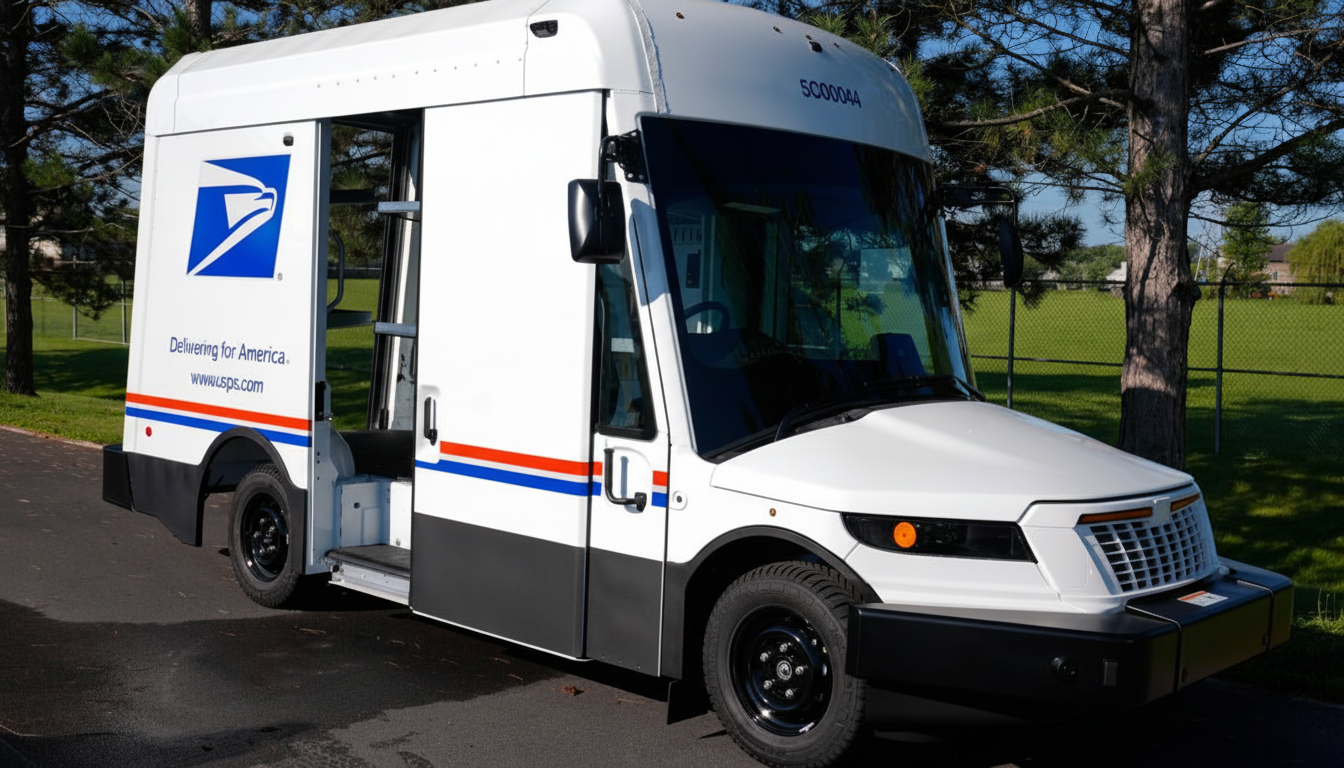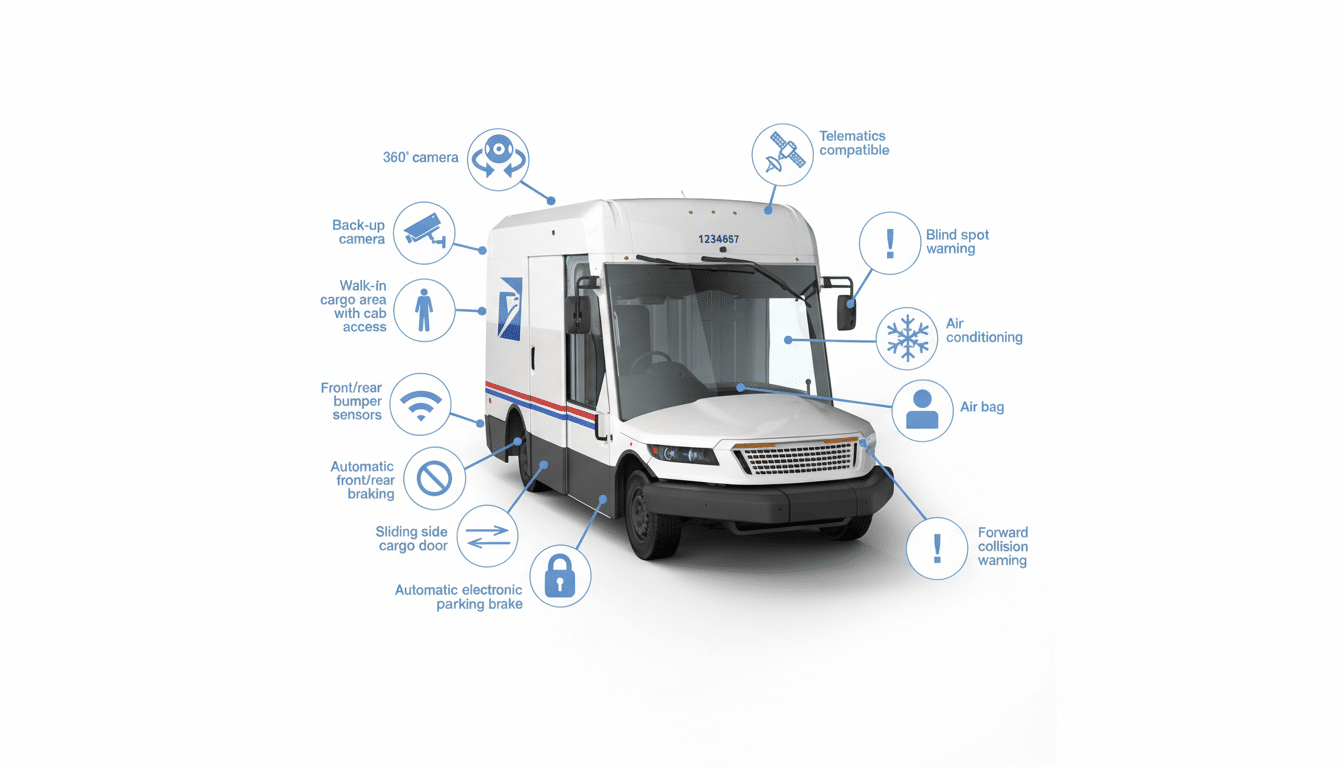The funniest-looking new EV in America wasn’t intended to win beauty contests. It was built to win routes. After test-driving the US Postal Service’s Next Generation Delivery Vehicle, it becomes evident why its cartoonish face exists — and perhaps that it may turn up on your street corner sooner than you think.
Built by Oshkosh Corp., the battery-electric NGDV defines modernity relative to its predecessor, aging Long Life Vehicles that were made before air conditioning and airbags. The stakes are high: USPS is heavily embracing electric power for stop-and-go routes, a duty cycle that’s ideal for EV efficiency and low operating costs.

A Shape Built for a Job on America’s Mail Routes
The NGDV’s swoopy hood, vertical windshield, and squarish, rhomboid body create a “platypus” profile that fans on delivery forums have used endearingly online. The humorless geometry is no joke; it paves the way for a cavernous cargo cavity in which carriers can stand, sort, and retrieve parcels efficiently and safely, reflecting a shift toward e-commerce deliveries that show no sign of abating.
Up front, the RHD position and giant side window mean getting bent over in your mailbox reach-ins is a snap.
And visibility is vast, thanks to a backup camera and exterior sensors for collision avoidance on those tight neighborhood loops.
Electric Where It Matters for Postal Delivery Work
The electric NGDV gets power from a 94 kWh lithium-ion pack that feeds the single-motor drive, while it also has a standard CCS charge port and aims to make the design life of the pack last at least ten years. Oshkosh’s engineering team also anticipates higher-energy-density packs will be on offer when replacements become due, further extending range or lightening the load without redesign of the vehicle.
On the road, the van feels like a modern EV: punchy power from a stop, an unexpectedly tight turning circle, and near-silent operation that’s appreciated on early-morning routes.
Because mail delivery is so start-stop, executives say they can often get two days out of a single charge for the truck — exactly when regenerative braking and low-speed efficiency have real payoff.
Inside, the dashboard is utilitarian and tough: no fancy touchscreens, just the basics (like Bluetooth for phone calls) and a long-missing cupholder that delivery drivers are likely to cheer. Less is more in a lot of ways, and less friction can lead to less failure, an observation from decades of punishing postal use.
Production Ramp and Real-World Numbers to Watch
Oshkosh says it has already delivered several thousand NGDVs to date and is growing production at its Spartanburg, South Carolina, plant to 16,000–20,000 units annually. USPS has begun taking delivery, including at least 500 battery-electric vehicles, of what for now is a 51,500-vehicle contract that calls for 35,000 electric vehicles.

The program’s scale is substantial. USPS originally awarded a $2.98 billion contract based on gas-powered vehicles, but then completely pivoted its focus to electric models using federal money allocated for fleet electrification. The greater plan for vehicle modernization stands at $9.6 billion and will reserve $3 billion to assist the EV versions (as well as the infrastructure that accompanies them).
That shift, along with the country’s typical supply-chain hiccups, delayed early shipments. The USPS Office of Inspector General has also taken issue with the drawn-out, custom procurement process, comparing it unfavorably to private-sector partnerships such as Amazon’s deal with Rivian. Charging-station installation has been another sticking point — slowed by permitting and procurement, issues that are not unique to private logistics fleets.
Behind the Wheel of the USPS Next-Gen Mail Truck
Behind the wheel, the NGDV doesn’t appear as if it were cobbled up from some bins of parts. Seating position makes curbside stops fluid; sightlines are excellent, and it uses both cameras and sensors when reversing near overcrowded mailboxes or tight alleys.
Oshkosh executives say that the sensor suite could help offer a larger canvas of municipal insights — including such potentially rich veins as mapping potholes, blocked bike lanes, or chronic parking pinch points — if the USPS chooses to employ anonymized data in civic planning.
That would make every route a rolling data set, increasing the value of a vehicle the agency has to deploy anyway.
Policy Crosswinds and the Business Case for EVs
The program has had its share of political turbulence, including a move in Congress that would require USPS to sell off its EVs and charging equipment at auction. That language was ultimately removed after the Senate parliamentarian deemed it out of order, though other changes curtailed tax incentives for consumer EVs — reminders that policy whiplash can always disrupt fleet plans.
Oshkosh’s approach is pragmatic: electrify if the economics work. For mail trucks, they do. That frequent stopping amps up regenerative gains, overnight depot charging eases operations, and quieter drivetrains enrich neighborhood soundscapes. It’s the same calculus leading schools and cities toward electric buses and refuse trucks; Oshkosh’s garbage haulers branded McNeilus and its plug-in hybrid fire engines are manifestations of that duty-cycle math.
What to Watch Next as NGDVs Near Wider Rollout
The remaining variables that will determine how quickly the NGDV appears on your block are mostly operational at this point: factories hitting and maintaining expected production goals, chargers getting installed in a timely manner at postal depots, and those necessary parts all keeping up with demand. If those pieces fall into place, the platypus-faced EV could become America’s most familiar electric vehicle — glimpsed not in a showroom but next to your mailbox.

